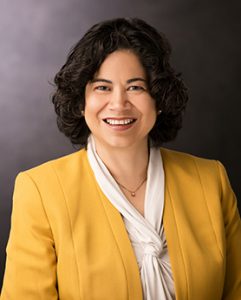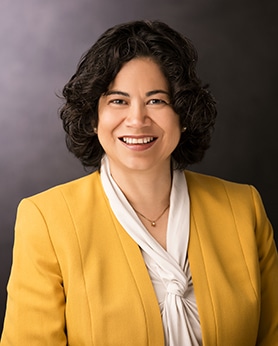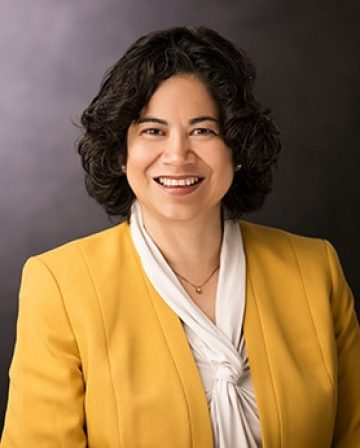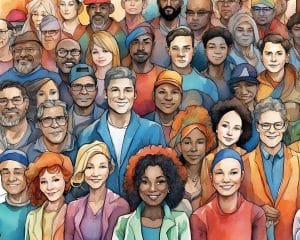 I like this topic – I think there’s something very uplifting in the idea of people, in all their diversity, coming together to act for good in the world. This is the theme of Reyna Aburto’s talk, “With One Accord.”
I like this topic – I think there’s something very uplifting in the idea of people, in all their diversity, coming together to act for good in the world. This is the theme of Reyna Aburto’s talk, “With One Accord.”
Introduction
Start out the lesson with an easy question that relates to the theme of the talk.
What are your favorite examples of unity in the scriptures? Any scriptural stories of deep loyalty or friendship that you have found compelling or meaningful? Why?
- Naomi and Ruth
- Jonathan and David
- Elizabeth and Mary
I’d personally mention Ruth and Naomi because that story of unity and devotion reminds me of my own mom and her mother-in-law. After my dad died when I was a baby, my mom would have liked to move back to her home town to be closer to her mom and sister, but she stayed where she was, a few blocks away from her in-laws, because we were their only grandchildren and she couldn’t bear to take us away from them. My mom took care of my father’s parents until they died in their 80s and 90s.
I might also comment on Elizabeth and Mary: I found a comment on the blog that nicely captures the dynamic of unity that Elizabeth and Mary shared when they were both pregnant and came together. “Mary turns to her for refuge. Elizabeth recognizes Mary’s distinct mission. Even their children-in-utero seem united. Mary, in this circle of acceptance, then speaks the gorgeous poem/prophecy (the magnificat). After the loneliness that must have accompanied her initial vision, Mary must have felt — upon meeting her “sister” — “‘How Good and how pleasant it is . . . to dwell together in unity.'”
Part I: Coming Together to do Good
Aburto begins by by talking about the remarkable journey of butterflies, as they fly from Mexico to Canada and back to Mexico. At night cluster together on trees for protection from predators and cold. She uses the monarch butterly as a central metaphor about the importance of unity as we all undergo our mortal journey.
A group of butterflies is called a kaleidoscope.4 Isn’t that a beautiful image? Each butterfly in a kaleidoscope is unique and different, yet these seemingly fragile creatures have been designed by a loving Creator with the ability to survive, travel, multiply, and disseminate life as they go from one flower to the next, spreading pollen. And although each butterfly is different, they work together to make the world a more beautiful and fruitful place.
Like the monarch butterflies, we are on a journey back to our heavenly home, where we will reunite with our Heavenly Parents.5 Like the butterflies, we have been given divine attributes that allow us to navigate through life, in order to “[fill] the measure of [our] creation.”6Like them, if we knit our hearts together,7 the Lord will protect us “as a hen [gathers] her chickens under her wings”8 and will make us into a beautiful kaleidoscope.
Girls and boys, young women and young men, sisters and brothers, we are on this journey together. In order to reach our sublime destiny, we need each other, and we need to be unified. The Lord has commanded us, “Be one; and if ye are not one ye are not mine.”9
She discusses a few examples of LDS people coming together with their communities to help in times of great need. During the floods in Houston last year, an Elders Quorum president sent out a plea for boats to come and help stranded people, and ultimately got 77 boats from members and non members to come and help people and give them rides to where they needed to go. In Chile a Relief Society president wanted to help Haitian immigrants that were arriving, so she and other leaders organized Spanish classes to help them integrate.
Do you have any stories of people coming together in unity to help out in times of crisis? These could be stories from newspapers or from your own lives. Maybe you’ve seen some these kinds of projects in your own church experience?
I might mention this story of unity — of people working together for good — that I thought was pretty neat. A year or two ago a family was caught in a rip tide off the coast of Florida and they couldn’t swim back to shore. Strangers on the beach saw what was happening and formed a human chain of 70 people to rescue the family.
https://www.nbcnews.com/news/us-news/strangers-form-70-person-human-chain-save-family-rip-current-n781746
For a Mormon example, I really liked this story about a ward in Utah that came together to makeover a house for a refugee from Rwanda, with ward members donating their various expertise to fix up the house. This is a great example of people working together to do something awesome that they couldn’t have done alone.
Part II: Creating Unity and Honoring Diversity
I like the idea of people coming together to work for good, but I do not like the idea of unity meaning we all look alike, think alike, act alike, speak alike. I’m completely uninterested in being in that kind of community. I like diversity. I like different perspectives. My favorite thing about these lessons is when people have different types of wisdom to share – it’s such a richer experience.
Does unity imply conformity to you? Why or why not? How do we honor diversity at the same time we create unity? Can we do both at the same time?
I would comment on what I think is one of the best scriptural discussions of the way diversity and unity come together to work for the common good — the body of Christ metaphor in the New Testament. 1 Corinthians 12: 12-27
2 Just as a body, though one, has many parts, but all its many parts form one body, so it is with Christ. 13 For we were all baptized by[a] one Spirit so as to form one body—whether Jews or Gentiles, slave or free—and we were all given the one Spirit to drink. 14 Even so the body is not made up of one part but of many.
15 Now if the foot should say, “Because I am not a hand, I do not belong to the body,” it would not for that reason stop being part of the body.16 And if the ear should say, “Because I am not an eye, I do not belong to the body,” it would not for that reason stop being part of the body.17 If the whole body were an eye, where would the sense of hearing be? If the whole body were an ear, where would the sense of smell be? 18 But in fact God has placed the parts in the body, every one of them, just as he wanted them to be. 19 If they were all one part, where would the body be? 20 As it is, there are many parts, but one body.
21 The eye cannot say to the hand, “I don’t need you!” And the head cannot say to the feet, “I don’t need you!” 22 On the contrary, those parts of the body that seem to be weaker are indispensable, 23 and the parts that we think are less honorable we treat with special honor. And the parts that are unpresentable are treated with special modesty,24 while our presentable parts need no special treatment. But God has put the body together, giving greater honor to the parts that lacked it,25 so that there should be no division in the body, but that its parts should have equal concern for each other. 26 If one part suffers, every part suffers with it; if one part is honored, every part rejoices with it.
27 Now you are the body of Christ, and each one of you is a part of it.
What are your thoughts about this passage? Does this resonate with your sense of how people — all different colors, backgrounds, ethnicities, ideologies, ages, education, etc.- can come together and find a place in the church? Or do you think this is far harder to achieve in reality than it is in theory. Why?
Part III: Creating Unity Within Diversity in our Relief Societies
I like these quotes from Relief Society leaders, who have wrestled with this issue of creating a unity that embraces diversity.
“It is a new time, it is a change of direction, it is a time to heal, a time to bond women to women and women to men. We can have unity in diversity and diversity in unity. We don’t have to be like one another to enjoy sisterhood. One of the important things we must do is to help the daughters of God know who they are and that they have had an important part in building his kingdom throughout all generations of time. Another of the most important things we can do is to learn to be accepting of one another and overcome judging one another, to learn to love aech other and build each other more. “ — Barbara Winder “Faith Hope and charity: inspiration from the lives of General Relief Society presidents.
“I am not typical of the ideal of Latter-day Saint womanhood. For example, I teach at a Catholic girls’ school; I was single until was thirty-eight years old; I have no children of my own… But paradoxically, I serve an important purpose by not fitting the traditional image. It would be difficult for someone in my stake to look me in the eye and say, “I just don’t think I fit the Relief Society mold!” I’m a daily reminder to our stake, for the time I’m serving in my present calling [as Stake Relief Society president], that the umbrella of The Church of Jesus Christ of Latter-day Saints is large and welcoming. It is not made to shelter one kind of woman only. I may lack some of the usual powers, but I may have some that are unique to me. There’s room for all of us, and what happiness we can find as we use our individual powers to teach, bless, and strengthen one another!” — Karen Lynn Davidson, 1990 Women’s Conference Address is “Women and the Power Within”
I think these two quotes give us some good ideas on how to create a more unified Relief Society. What are your ideas? What concrete practical ideas do you have for how we can come together, appreciate each other’s strengths, and welcome the diverse talents and perspectives that we all have?
Conclusion:
End with this thought from Sister Aburto.
Like the monarch butterflies, let us continue on our journey together in purpose, each of us with our own attributes and contributions, working to make this a more beautiful and fruitful world—one small step at a time and in harmony with God’s commandments.






2 Responses
What is the reference for your 1 Corinthians quote?
Bless you for this! I am filling in for a sister and I really appreciate amazing people who are so willing to share their talents. <3